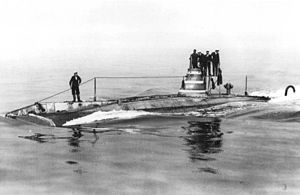HMS A4
 HMS A3
| |
| History | |
|---|---|
| Name | HMS A4 |
| Builder | Vickers, Barrow-in-Furness |
| Laid down | 19 February 1902 |
| Launched | 9 June 1903 |
| Commissioned | 17 July 1904 |
| Fate | Sold for scrapping 16 January 1920 |
| General characteristics | |
| Class and type | A-class submarine |
| Displacement | 190 tons surfaced, 207 tons submerged |
| Length | 105.25 ft (32.08 m) |
| Beam | 12.75 ft (3.89 m) |
| Complement | 11 (2 officers and 9 ratings) |
| Armament | 2 × 18 inch (450 mm) torpedo tubes, plus two reloads |
HMS A4 was an early Royal Navy submarine.
She was a member of the first British
submarines. Like all her class, she was built at Vickers, Barrow-in-Furness
.
Service history
A4 suffered a serious accident, although without casualties, on 16 October 1905 during an underwater signalling experiment off Spithead.
A
bell had been lowered into the water from a dinghy some distance away from the submarine was being used to signal to the submarine, which was running awash. A flag on a boat hook
protruding through a ventilator which had been left open was used to indicate that the signal had been heard. The experiment had been performed successfully on the previous day, but the sea was much rougher on 16 October and consequently the submarine stayed inside the breakwater.
The same trim settings had been used as on the previous day, but as there was fresh water flowing into the harbour, the water was less dense and so the submarine was less buoyant than on the previous day.
Seawater flooded through the ventilator causing the boat to develop a 40 degree inclination on the bow and dive to 90 feet (27 m) and also partially filling her with
Dardanelles campaign
in 1915.
During the First World War she was used for training at Portsmouth, and was sold for scrap on 16 January 1920.[1]
References
- ISBN 0-7110-0380-7.
- Royal Navy Submarine museum Archived 7 January 2018 at the Wayback Machine
